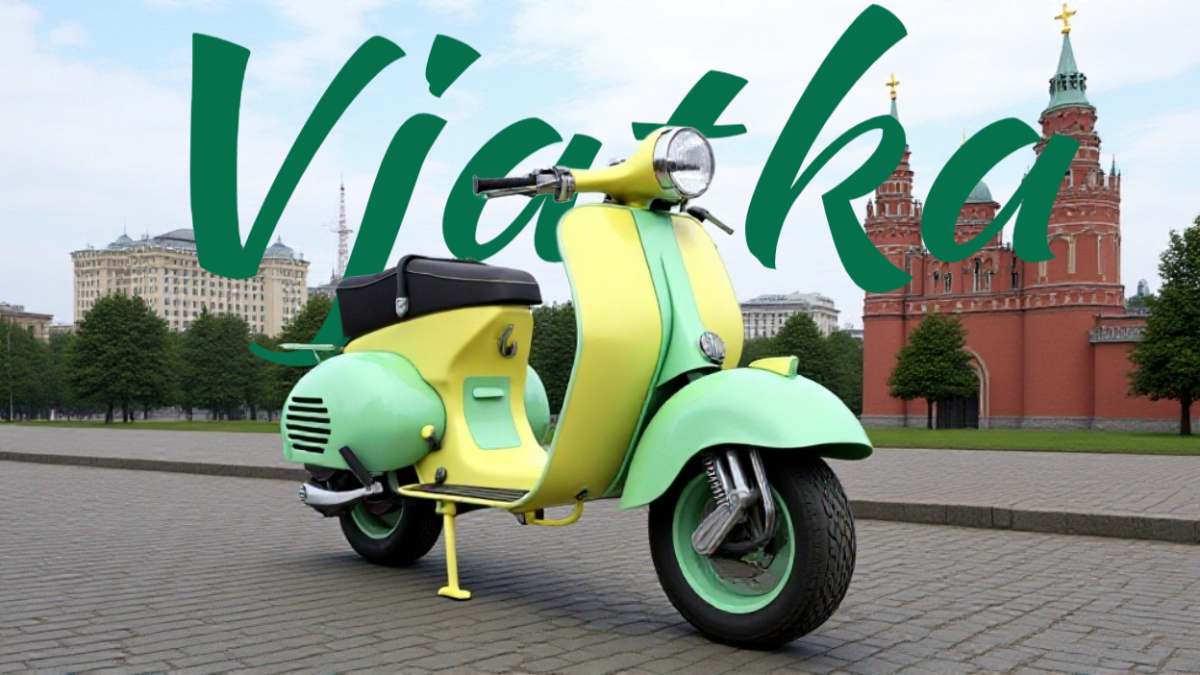- Posted on
- • History
Vjatka VP150 – The "Russian Vespa" That Out-Steeled the Italians
- Author
-
-

- User
- Torque
- Posts by this author
- Posts by this author
-

Vjatka VP150 – the "Russian Vespa" that photocopied Piaggio, out-steeled the Italians and became a Cold-War cult collectible
Reading time: 5 min | Word count: ≈ 820
1. 1956 – the Iron-Curtain Xerox Machine
While Vespa sales boomed in Western Europe, the USSR needed cheap private transport for the post-war commuter. Rather than negotiate a licence, the Vyatskiye Polyany Machine-Building Plant (VPMZ) – until then a gramophone and artillery manufacturer – simply bought a Vespa 150 GL, stripped it to molecules and copied every curve.
The result, unveiled in December 1956, was christened Vjatka VP150 – "Vjatka" after the local river and horse breed, "150" for its 147 cc engine.
2. "Not a single interchangeable part" – how the Soviets reverse-engineered Vespa
Piaggio later admitted "not a single bolt interchanges", yet the silhouette is unmistakably Vespa:
- Steel monocoque frame with pressed-steel fork arm.
- Horizontal cylinder, rear-mounted engine, side cowl vents.
- Twist-grip 3-speed, 10-inch wheels, centre-stand.
Differences: thicker 2 mm steel (vs 1.5 mm Vespa) to cope with Soviet potholes, 10 × 4.0 tyres (vs 3.5), adjustable headlamp (tool-free wing-nut) and a glove-box under the front seat – something Vespa wouldn't adopt until the 1960s.
3. Thicker steel, bigger tyres, adjustable headlamp – the VP150's Soviet upgrades
| Feature | Vjatka VP150 | Vespa 150 GL (1956) |
|---|---|---|
| Steel thickness | 2 mm | 1.5 mm |
| Tyres | 10 × 4.0 | 10 × 3.5 |
| Headlamp | Adjustable nacelle | Fixed |
| Front rack | Standard | Optional accessory |
| Glove-box | Under seat | None |
| Weight | 114 kg | 98 kg |
| Tank | 9.5 L | 8.5 L |
Result: heavier, slower, but almost indestructible – perfect for gravel roads outside Moscow.
4. Engine & numbers – 147 cc of rotary-disc two-stroke that loved 25:1
| Spec | Figure |
|---|---|
| Engine | 147.9 cc, air-cooled, rotary-disc-valve, 2-stroke |
| Bore × stroke | 57 × 58 mm |
| Power | 5.5 bhp @ 5,000 rpm (restricted) |
| Compression | 7.8 : 1 |
| Carb | 19 mm K-37 (Soviet copy of Dell'Orto) |
| Gearbox | 3-speed, twist-grip, right-foot change on UK imports |
| Oil mix | 25:1 (Soviet mineral) – smoke screen worthy of a Bond film |
| Top speed | 90 km/h (56 mph) de-restricted; 70 km/h on paper |
Total VP150 production: ≈ 300,000 units 1957-1965 – largest two-wheeler run in USSR until the V-150M successor.
5. UK youth adopt the "Russian Vespa" – mods, music and L-plate credibility
Grey-imports arrived 1960-62 via Eastern-bloc trading companies; price £189 – £40 cheaper than a Vespa 150.
Mods loved the chrome rear rack, adjustable headlamp and mystique of the Iron Curtain; de-coked barrels, up-jetted carbs and clip-on bars saw 70 mph on the A10.
Scooter clubs such as Leicester's "Red Stars" ran "East vs West" rallies – Vespa vs Vjatka – the Soviet bike often winning the endurance leg thanks to thicker metal and bigger tank.
6. Piaggio fights back – lawyers, diplomats and the 1965 production halt
1963: Piaggio filed diplomatic protests via the Italian embassy in Moscow, claiming "industrial plagiarism".
1964: USSR Ministry of Light Industry quietly told VPMZ to "develop a new model"; VP150 production ceased 1965.
1966: V-150M launched with tubular frame, chain drive and new bodywork – no longer a Vespa clone, production continued until 1979 (1 million+ units).
7. From £300 beater to £6k collectible – auction curve and survivor count
- 2013 Bruce Weiner sale: 1958 VP150 – $4,500 (£2,900).
- 2021 RM Sotheby's online: matching-numbers, original paint – €5,500 (£4,700).
- 2023 private UK sale: restored, UK-supplied, twin-carb Sport – £6,200.
Survivors outside CIS: < 600; UK DVLA lists 47 taxed examples – rarer than a 1960s Lambretta TV175.
8. 60-second buyer checklist – VIN, cracks, colours, carbs
- VIN plate on leg-shield – should read "VP-150" + 6-digit serial; no plate = 25% price drop.
- Engine number – starts "V-150"; mismatch acceptable if documented import swap.
- Chrome rear rack – standard on export bikes, missing = £200 to fabricate.
- Crack test – look for stress lines around headset weld and floorboard front edge – thick steel, but 60 years old.
- Colour: 1957-59 – metallic blue; 1960-62 – ivory or military green; 1963-65 – black or red – verify with factory list.
9. Quick-fire FAQ – oil ratio, spares, Sport vs Standard, French market
Q1. Oil mix for everyday use?
25:1 with modern semi-synthetic; castor 20:1 for show-day smell – expect plug chops every 200 km.
Q2. Where do I find K-37 carb parts?
Vintage Scooter Parts (Latvia) – €80 rebuild kit; alternative is 19 mm Dell'Orto – bolt-on if you re-jet.
Q3. Is there a "Sport" version?
No factory Sport, but UK dealers fitted twin 16 mm carbs and expansion pipes – period mods add £800 to value if documented.
Q4. Will UK DVLA accept frame-only restoration?
Yes – original V5 + dating letter from VPMZ museum; engine number must match log-book or be accompanied by import paperwork.
Q5. Do I need lead additive?
No – iron-lined barrel is hard enough; lead substitute won't adhere – use 98 RON + octane booster for extended high-rpm running.
Bottom Line
The Vjatka VP150 was the USSR's photocopied love-letter to Italian design – thicker, heavier, slower, but almost indestructible and £6,000 collector candy today.
It gave 16-year-old British mods an affordable ticket to the Ace Café, survived Siberian gravel and lawyers' letters, and still puffs blue smoke at vintage rallies from Moscow to Manchester.
If you crave Cold-War conversation-piece that out-Vespas Vespa fans on rarity alone, track down a VP150 – just budget for 25:1 premix and prepare to explain the glove-box every time you lift the seat.
